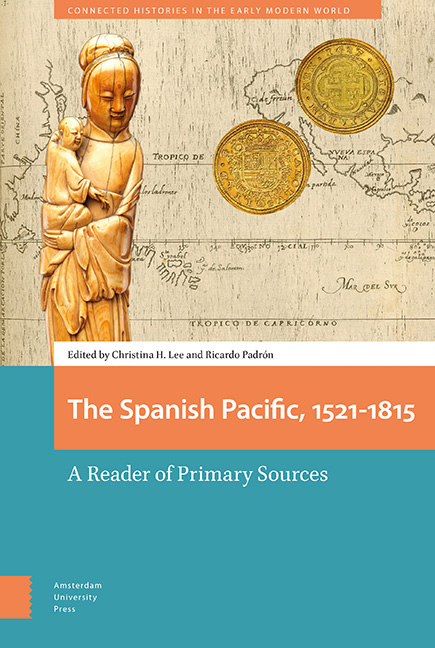Book contents
- Frontmatter
- Contents
- Abbreviations
- Acknowledgements
- Introduction
- 1 An Early Transpacific Account of the Spice Islands by Andrés de Urdaneta (1536)
- 2 Domingo de Salazar’s Letter to the King of Spain in Defense of the Indians and the Chinese of the Philippine Islands (1582)
- 3 Juan Cobo’s Map of the Pacific World (1593)
- 4 A Royal Decree of Philip III Regulating Trade between the Philippines and New Spain (1604)
- 5 Manila’s Sangleys and a Chinese Wedding (1625)
- 6 Don Luis Castilla Offers to Sell Land in Manila (1629)
- 7 Idolatry and Apostasy in the 1633 Jesuit Annual Letter
- 8 The Will of an Indian Oriental and her Chinos in Peru (1644
- 9 Francisco de Combés’s History of Mindanao and Jolo (1667)
- 10 Between Fiction and History in the Spanish Pacific The Misfortunes of Alonso Ramírez (1690)
- 11 A Moluccan Crypto-Muslim before the Transpacific Inquisition (1623–1645)
- 12 Constitutions and Rules of the Beatas Indias (1726)
- 13 The Poetics of Praise and the Demands of Confession in the Early Spanish Philippines: Notes and Documents
- 14 The Pacific Theater of the Seven Years’ War in a Latin Poem by an Indigenous Priest, Bartolomé Saguinsín (1766)
- 15 A Prohibition on Digging Up the Bones of the Dead (1813)
- Index
13 - The Poetics of Praise and the Demands of Confession in the Early Spanish Philippines: Notes and Documents
Published online by Cambridge University Press: 20 November 2020
- Frontmatter
- Contents
- Abbreviations
- Acknowledgements
- Introduction
- 1 An Early Transpacific Account of the Spice Islands by Andrés de Urdaneta (1536)
- 2 Domingo de Salazar’s Letter to the King of Spain in Defense of the Indians and the Chinese of the Philippine Islands (1582)
- 3 Juan Cobo’s Map of the Pacific World (1593)
- 4 A Royal Decree of Philip III Regulating Trade between the Philippines and New Spain (1604)
- 5 Manila’s Sangleys and a Chinese Wedding (1625)
- 6 Don Luis Castilla Offers to Sell Land in Manila (1629)
- 7 Idolatry and Apostasy in the 1633 Jesuit Annual Letter
- 8 The Will of an Indian Oriental and her Chinos in Peru (1644
- 9 Francisco de Combés’s History of Mindanao and Jolo (1667)
- 10 Between Fiction and History in the Spanish Pacific The Misfortunes of Alonso Ramírez (1690)
- 11 A Moluccan Crypto-Muslim before the Transpacific Inquisition (1623–1645)
- 12 Constitutions and Rules of the Beatas Indias (1726)
- 13 The Poetics of Praise and the Demands of Confession in the Early Spanish Philippines: Notes and Documents
- 14 The Pacific Theater of the Seven Years’ War in a Latin Poem by an Indigenous Priest, Bartolomé Saguinsín (1766)
- 15 A Prohibition on Digging Up the Bones of the Dead (1813)
- Index
Summary
Abstract
This chapter combines two very different but intimately related texts. On the one hand, it reproduces three dalits, devotional poems by Tagalog natives praising the work of Catholic missionaries. On the other, it provides a questionnaire from an eighteenth-century confessional manual used by missionaries to administer the sacrament of Penance. Vicente L. Rafael argues that each text embodies a different attitude toward the written word in the religious life of the colonial Philippines. For the Tagalog authors of the dalits, the book becomes a magical talisman of sorts. For the missionaries, it provides the tactics of an intimate disciplinary strategy meant to alter the behavior of Filipino natives.
Keywords: Filipino poetry; colonial religion; culture of the book; biopolitics
The documents below consist of two kinds of writing: a series of dalit—a kind of devotional poetry praising the works of missionaries written by Tagalog natives—and an excerpt from a bilingual confessional manual by a Franciscan friar typical of guides used by Spanish priests to aid them in hearing the confessions of native converts. Both sets of documents were published in the Philippines during the early part of Spanish colonial rule between the late sixteenth to the mid-eighteenth centuries. In trying to understand these texts, we might begin by asking: what is relationship between the discourses of devotion and the practice of confession?
In the vernacular devotional poems, praise is directed to the book itself. Referred to by the Spanish word libro or by the vernacular term, sulat by the Tagalog poets, the book comes across as the object of esteem radiating a kind of magical power. For this reason, it was a source of great fascination and attachment for native converts. This intense fascination may have to do with the novelty of the book as such: the very first book published in the Philippines after all was the Doctrina Christiana (1593), a catechism that contained a confessional manual. In the printed books introduced by the Spanish missionaries, Latin letters replaced the native baybayin script.
- Type
- Chapter
- Information
- Spanish Pacific, 1521–1815A Reader of Primary Sources, pp. 205 - 222Publisher: Amsterdam University PressPrint publication year: 2020



